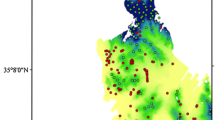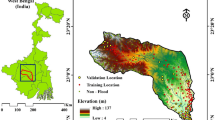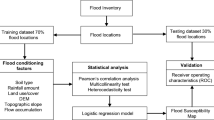Abstract
The city of Jeddah (Saudi Arabia) has experienced two catastrophic flash flood events in 2009 and 2011. These flood events had catastrophic effect on human lives and livelihoods around the wadi Muraikh, wadi Qus, wadi Methweb, and wadi Ghulail in which 113 people were dead and with 10,000 houses and 17,000 vehicles were damaged. Thus, a comprehensive flood management is required. The flood management requires information on different aspects such as the hydrological, geotechnical, environmental, social, and economic aspects of flooding. Flood susceptibility mapping for any area helps the decision makers to understand the flood trends and can aid in appropriate planning and flood prevention. In this study, two models were used for the generation of flood susceptibility maps for the Jeddah region. The first model includes bivariate probability analysis (frequency ratio), and the second model uses the multivariate analysis. For the multivariate model, the acquired weights of the FR model were entered into the logistic regression model to evaluate the correlation between flood occurrence and each related factor. This integration will overcome some of the weakness of the logistic regression, and the performance the LR will be enhanced. A flood inventory map was prepared with a total of 127 flood locations. These flood locations were extracted from different sources including field investigation and high-resolution satellite image (IKONOS 1 m). These flood locations were randomly split into two groups, one dataset representing 70 % was used for training the models, and the remaining 30 % was used for models validation. Various independent flood-related factors such as slope, elevation, curvature, geology, landuse, soil drain, and distance from streams were included. The impact of each independent flood-related factors on flooding was evaluated by analyzing each independent factor with the historical flood inventory data. The training and validation datasets were used to evaluate the flood susceptibility maps using the success and the prediction rate methods. The results of the accuracy assessment showed a success rate of 90.4 and 91.6 % and a prediction rate of 89.6 and 91.3 % for FR and ensemble FR and LR models, respectively. In addition, a comparison has been made between real flood events in 2009 and the resultant susceptibility maps. Hence, it is concluded that the FR and ensemble Fr and LR models can provide an acceptable accuracy in the prediction of flood susceptibility in the Saudi Arabia. Our findings indicated that these flood susceptibility maps can assist planners, decision makers, and other agencies to deal with the flood management and planning in the area.







Similar content being viewed by others
References
Akgun A, Sezer EA, Nefeslioglu HA, Gokceoglu C, Pradhan B (2012) An easy-to-use MATLAB program (MamLand) for the assessment of landslide susceptibility using a Mamdani fuzzy algorithm. Comput Geosci 38(1):23–34. doi:10.1016/j.cageo.2011.04.012
Alexander D (1993) Natural disasters. UCL Press, London, p 631
Ayalew L, Yamagishi H (2005) The application of GIS-based logistic regression for landslide susceptibility mapping in the Kakuda- Yahiko Mountains, Central Japan. Geomorphology 65:15–31. doi:10.1016/j.geomorph.2004.06.010
Billa L, Shattri M, Mahmud AR, Ghazali AH (2006) Comprehensive planning and the role of SDSS in flood disaster management in Malaysia. Disaster Prev Manage 15:233–240. doi:10.1108/09653560610659775
Bubeck P, Botzen W, Aerts J (2012) A review of risk perceptions and other factors that influence flood mitigation behavior. Risk Anal 32:1481–1495. doi:10.1111/j.1539-6924.2011.01783.x
Campolo M, Soldati A, Andreussi P (2003) Artificial neural network approach to flood forecasting in the River Arno. Hydrol Sci J 48:381–398
Chau K, Wu C, Li Y (2005) Comparison of several flood forecasting models in Yangtze River. J Hydrol Eng 10:485–491. doi:10.1061/ASCE1084-0699(2005)10:6(485)
Chauhan S, Sharma M, Arora MK (2010) Landslide susceptibility zonation of the Chamoli region, Garhwal Himalayas, using logistic regression model. Landslides 7:411–423. doi:10.1007/s10346-010-0202-3
Dai FC, Lee CF (2002) Landslide characteristics and slope instability modeling using GIS, Lantau Island, Hong Kong. Geomorphology 42:213–228
Dawod GM, Mirza MN, Al-Ghamdi KA (2012) GIS-based estimation of flood hazard impacts on road network in Makkah city, Saudi Arabia. Environ Earth Sci 67:2205–2215. doi:10.1007/s12665-012-1660-9
De Moel H, Aerts J (2011) Effect of uncertainty in landuse, damage models and inundation depth on flood damage estimates. Nat Hazards 58:407–425. doi:10.1007/s11069-010-9675-6
Elbialy S, Mahmoud A, Pradhan B, Buchroithner M (2013) Application of spaceborne synthetic aperture radar data for extraction of soil moisture and its use in hydrological modelling at Gottleuba Catchment, Saxony, Germany. J Flood Risk Manag. doi:10.1111/jfr3.12037
Feng CC, Wang YC (2011) GIScience research challenges for emergency management in Southeast Asia. Nat Hazards 59:597–616. doi:10.1007/s11069-011-9778-8
Green CH, Penning-Rowsell EC (1989) Flooding and the quantification of intangibles. J Inst Water Env Man 3(1):27–30
Hassan OA (2000) Salient geoenvironmental parameters of Ras Malaab—Abu Zenima Area, Gulf of Suez, Egypt, with an emphasis on flash flood potential and mitigative measures; Egypt. J Remote Sensing Space Sci 3:37–58
Kia MB, Pirasteh S, Pradhan B, Mahmud AR, Sulaiman WNA, Moradi A (2012) An artificial neural network model for flood simulation using GIS: Johor River Basin, Malaysia. Environ Earth Sci 67:251–264. doi:10.1007/s12665-011-1504-z
Kjeldsen TR (2010) Modelling the impact of urbanization on flood frequency relationships in the UK. Hydrol Res 41:391–405. doi:10.2166/nh.2010.056
Kourgialas NN, Karatzas GP (2011) Flood management and a GIS modelling method to assess flood-hazard areas—a case study. Hydrol Sci J 56:212–225. doi:10.1080/02626667.2011.555836
Lee S, Min K (2001) Statistical analysis of landslide susceptibility at Yongin, Korea. Environ Geol 40:1095–1113. doi:10.1007/s002540100310
Lee S, Pradhan B (2006) Probabilistic landslide hazards and risk mapping on Penang Island, Malaysia. J Earth Syst Sci 115(6):661–672
Lee S, Pradhan B (2007) Landslide hazard mapping at Selangor, Malaysia using frequency ratio and logistic regression models. Landslides 4:33–41. doi:10.1007/s10346-006-0047-y
Lee S, Sambath T (2006) Landslide susceptibility mapping in the Damrei Romel area, Cambodia using frequency ratio and logistic regression models. Environ Geol 50:847–855. doi:10.1007/s00254-006-0256-7
Lee S, Talib JA (2005) Probabilistic landslide susceptibility and factor effect analysis. Environ Geol 47:982–990. doi:10.1007/s00254-005-1228-z
Lee S, Ryu JH, Kim IS (2007) Landslide susceptibility analysis and its verification using likelihood ratio, logistic regression, and artificial neural network models: case study of Youngin, Korea. Landslides 4:327–338. doi:10.1007/s10346-007-0088-x
Lee MJ, Kang JE, Jeon S (2012) Application of frequency ratio model and validation for predictive flooded area susceptibility mapping using GIS. In: Geoscience and remote sensing symposium (IGARSS), 2012 IEEE International, Munich, pp 895–898
Liu Y, De Smedt F (2005) Flood modeling for complex terrain using GIS and remote sensed information. Water Resour Manag 19:605–624. doi:10.1007/s11269-005-6808-x
Maier HR, Dandy GC (2000) Neural networks for the prediction and forecasting of water resources variables: a review of modelling issues and applications. Environ Model Softw 15:101–124. doi:10.1016/S1364-8152(99)00007-9
Martinez JM, Le Toan T (2007) Mapping of flood dynamics and spatial distribution of vegetation in the Amazon floodplain using multitemporal SAR data. Remote Sens Environ 108:209–223. doi:10.1016/j.rse.2006.11.012
Mason DC, Speck R, Devereux B, Schumann GP, Neal JC, Bates PD (2010) Flood detection in urban areas using TerraSAR-X. IEEE Trans Geosci Remote 48:882–894. doi:10.1109/TGRS.2009.2029236
Matori A (2012) Detecting flood susceptible areas using GIS-based analytic hierarchy process. In: International conference on future environment and energy, Singapore
Moore TA, Al-Rehaili MH (1989) Geologic Map of the Makkah Quadrangle, sheet 21D, Kingdom of Saudi Arabia, Saudi Arabian Directorate General of Mineral Resources Geoscience Map GM-107C, scale 1:250,000
Mukerji A, Chatterjee C, Raghuwanshi NS (2009) Flood forecasting using ANN, neuro-fuzzy, and neuro-GA models. J Hydrol Eng 14:647–652. doi:10.1061/(ASCE)HE.1943-5584.0000040
Papadopoulou-Vrynioti K, Bathrellos GD, Skilodimou HD, Kaviris G, Makropoulos K (2013) Karst collapse susceptibility mapping considering peak ground acceleration in a rapidly growing urban area. Eng Geol 158:77–88. doi:10.1016/j.enggeo.2013.02.009
Park S, Choi C, Kim B, Kim J (2013) Landslide susceptibility mapping using frequency ratio, analytic hierarchy process, logistic regression, and artificial neural network methods at the Inje area, Korea. Environ Earth Sci 68:1443–1464. doi:10.1007/s12665-012-1842-5
Pourghasemi HR, Pradhan B, Gokceoglu C (2012) Application of fuzzy logic and analytical hierarchy process (AHP) to landslide susceptibility mapping at Haraz watershed, Iran. Nat Hazards 63:965–996. doi:10.1007/s11069-012-0217-2
Pradhan B (2010a) Flood susceptible mapping and risk area delineation using logistic regression, GIS and remote sensing. J Spat Hydrol 9(2):1–18
Pradhan B (2010b) Landslide susceptibility mapping of a catchment area using frequency ratio, fuzzy logic and multivariate logistic regression approaches. J Indian Soc Remote 38:301–320. doi:10.1007/s12524-010-0020-z
Pradhan B, Lee S (2010a) Delineation of landslide hazard areas on Penang Island, Malaysia, by using frequency ratio, logistic regression, and artificial neural network models. Environ Earth Sci 60:1037–1054. doi:10.1007/s12665-009-0245-8
Pradhan B, Lee S (2010b) Landslide susceptibility assessment and factor effect analysis: backpropagation artificial neural networks and their comparison with frequency ratio and bivariate logistic regression modelling. Environ Model Softw 25:747–759. doi:10.1016/j.envsoft.2009.10.016
Pradhan B, Lee S (2010c) Regional landslide susceptibility analysis using back-propagation neural networks model at Cameron Highland, Malaysia. Landslides 7(1):13–30. doi:10.1007/s10346-009-0183-2
Pradhan B, Youssef AM, Varathrajoo R (2010) Approaches for delineating landslide hazard areas using different training sites in an advanced neural network model. Geo-spat Inf Sci 13:93–102. doi:10.1007/s11806-010-0236-2
Pradhan B, Hagemann U, Tehrany MS, Prechtel N (2014) An easy to use ArcMap based texture analysis program for extraction of flooded areas from TerraSAR-X satellite image. Comput Geosci 63:34–43. doi:10.1016/j.cageo.2013.10.011
Qari MHT (2009) Geomorphology of Jeddah governorate, with emphasis on drainage systems. JKAU Earth Sci 20(1):93–116
Regmi AD, Yoshida K, Dhital MR, Pradhan B (2013) Weathering and mineralogical variation in gneissic rocks and their effect in Sangrumba Landslide, East Nepal. Environ Earth Sci 71(6):2711–2727. doi:10.1007/s12665-013-2649-8
Rozos D, Bathrellos GD, Skillodimou HD (2011) Comparison of the implementation of rock engineering system and analytic hierarchy process methods, upon landslide susceptibility mapping, using GIS: a case study from the Eastern Achaia County of Peloponnesus, Greece. Environ Earth Sci 63:49–63. doi:10.1007/s12665-010-0687-z
Sanyal J, Lu X (2004) Application of remote sensing in flood management with special reference to monsoon Asia: a review. Nat Hazards 33:283–301. doi:10.1023/B:NHAZ.0000037035.65105.95
Skilodimou H, Livaditis G, Bathrellos G, Verikiou-Papaspiridakou E (2003) Investigating the flooding events of the urban regions of Glyfada and Voula, Attica, Greece: a contribution to Urban Geomorphology. Geogr Ann A 85:197–204
Taylor J, Davies M, Clifton D, Ridley I, Biddulph P (2011) Flood management: prediction of microbial contamination in largescale floods in urban environments. Environ Int 37:1019–1029. doi:10.1016/j.envint.2011.03.015
Tehrany MS, Pradhan B, Jebur MN (2013) Spatial prediction of flood susceptible areas using rule based decision tree (DT) and a novel ensemble bivariate and multivariate statistical models in GIS. J Hydrol 504:69–79. doi:10.1016/j.jhydrol.2014.03.008
Tehrany MS, Pradhan B, Jebur MN (2014a) Flood susceptibility mapping using a novel ensemble weights-of-evidence and support vector machine models in GIS. J Hydrol 512:332–343. doi:10.1016/j.jhydrol.2014.03.008
Tehrany MS, Lee MJ, Pradhan B, Jebur MN, Lee S (2014b) Flood susceptibility mapping using integrated bivariate and multivariate statistical models. Environ Earth Sci. doi:10.1007/s12665-014-3289-3
Tehrany MS, Pradhan B, Mansor S, Ahmad N (2015) Flood susceptibility assessment using GIS-based support vector machine model with different kernel types. Catena 125:91–101. doi:10.1016/j.catena.2014.10.017
Tien Bui D, Pradhan B, Lofman O, Revhaug I, Dick OB (2012) Landslide susceptibility mapping at Hoa Binh province (Vietnam) using an adaptive neuro-fuzzy inference system and GIS. Comput Geosci 45:199–211. doi:10.1016/j.cageo.2011.10.031
Umar Z, Pradhan B, Ahmad A, Jebur MN, Tehrany MS (2014) Earthquake induced landslide susceptibility mapping using an integrated ensemble frequency ratio and logistic regression models in West Sumatera Province, Indonesia. Catena 118:124–135. doi:10.1016/j.catena.2014.02.005
Yi CS, Lee JH, Shim MP (2010) GIS-based distributed technique for assessing economic loss from flood damage: pre-feasibility study for the Anyang Stream Basin in Korea. Nat Hazards 55:251–272. doi:10.1007/s11069-010-9524-7
Yilmaz I (2009) Landslide susceptibility mapping using frequency ratio, logistic regression, artificial neural networks and their comparison: a case study from Kat landslides (Tokat—Turkey). Comput Geosci 35:1125–1138. doi:10.1016/j.cageo.2008.08.007
Youssef AM (2015) Landslide susceptibility delineation in the Ar-Rayth Area, Jizan, Kingdom of Saudi Arabia, by using analytical hierarchy process, frequency ratio, and logistic regression models. Environ Earth Sci. doi:10.1007/s12665-014-4008-9
Youssef AM, Hegab MA (2005) Using geographic information systems and statistics for developing a database management system of the flood hazard for Ras Gharib area, Eastern Desert, Egypt. In: The fourth international conference on the geology of Africa, Assiut, Egypt, November, vol 2, pp 1–15
Youssef AM, Abdel Moneim AA, Abu El-Maged SA (2005) Flood hazard assessment and its associated problems using geographic information systems, Sohag Governorate, Egypt. In: The fourth international conference on the geology of Africa, Assiut, Egypt, November, vol 1, pp 1–17
Youssef AM, Pradhan B, Gaber AFD, Buchroithner MF (2009a) Geomorphological hazards analysis along the Egyptian Red Sea Coast between Safaga and Quseir. Nat Hazards Earth Syst Sci 9:751–766. doi:10.1007/s12665-014-3661-3
Youssef AM, Maerz NH, Hassan AM (2009b) Remote sensing applications to geological problems in Egypt: case study, slope instability investigation, Sharm El-Sheikh/Ras-Nasrani Area, Southern Sinai. Landslides 6(4):353–360. doi:10.1007/s10346-009-0158-3
Youssef AM, Pradhan B, Maerz NH (2013) Debris flow impact assessment caused by 14 April 2012 rainfall along the Al-Hada Highway, Kingdom of Saudi Arabia using high-resolution satellite imagery. Arab J Geosci. doi:10.1007/s12517-013-0935-0
Youssef AM, Al-kathery M, Pradhan B (2014a) Landslide susceptibility mapping at Al-Hasher Area Jizan (Saudi Arabia) using GIS-based frequency ratio and index of entropy models. Geosci J. doi:10.1007/s12303-014-0032-8
Youssef AM, Pradhan B, Jebur MN, El-Harbi HM (2014b) Landslide susceptibility mapping using ensemble bivariate and multivariate statistical models in Fayfa area Saudi Arabia. Environ Earth Sci. doi:10.1007/s12665-014-3661-3
Youssef AM, Al-kathery M, Pradhan B, Elsahly T (2014c) Debris flow impact assessment along the Al-Raith Road, Kingdom of Saudi Arabia, using remote sensing data and field investigations. Geomat Nat Hazards Risk. doi:10.1080/19475705.2014.933130
Youssef AM, Sefry SA, Pradhan B, Abu Alfadail E (2015) Analysis on causes of flash flood in Jeddah city (Kingdom of Saudi Arabia) of 2009 and 2011 using multi-sensor remote sensing data and GIS. Geomat Nat Hazards Risk. doi:10.1080/19475705.2015.1012750
Zwenzner H, Voigt S (2009) Improved estimation of flood parameters by combining space based SAR data with very high resolution digital elevation data. Hydrol Earth Syst Sci 13:567–576. doi:10.5194/hess-13-567-2009
Acknowledgments
Authors would like to thank two anonymous reviewers for their valuable comments and editorial comments of Prof. James W. LaMoreaux.
Author information
Authors and Affiliations
Corresponding author
Rights and permissions
About this article
Cite this article
Youssef, A.M., Pradhan, B. & Sefry, S.A. Flash flood susceptibility assessment in Jeddah city (Kingdom of Saudi Arabia) using bivariate and multivariate statistical models. Environ Earth Sci 75, 12 (2016). https://doi.org/10.1007/s12665-015-4830-8
Received:
Accepted:
Published:
DOI: https://doi.org/10.1007/s12665-015-4830-8




